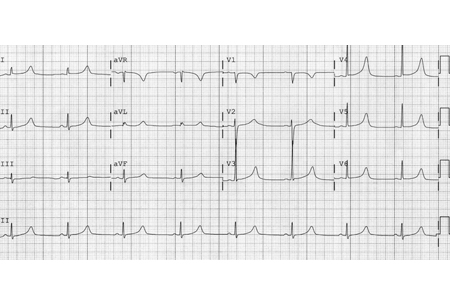Resumo
Definition
History and exam
Key diagnostic factors
- história de mutação genética conhecida
- uso de medicamentos ou circunstâncias conhecidos por aumentar o intervalo QT
- síncope durante elevações do tônus adrenérgico
- síncope durante excitação ou surpresa
- sintomas arrítmicos pós-parto
- síncope no repouso e durante bradicardia
- síncope cardíaca
- palpitações
- paralisia periódica
- características dismórficas
- surdez neurossensorial
Other diagnostic factors
- tontura
- angina
- fadiga
- oligúria
- fraqueza muscular
- tetania
- dormência
- sinal de Chvostek
- sinal de Trousseau
- membros frios e pálidos
- hipotensão
- confusão
Risk factors
- mutações no gene KCNQ1
- mutações no gene KCNH2
- mutações no gene SCN5A
- medicamentos que prolongam o intervalo QT
- hipocalemia
- hipomagnesemia
- hipocalcemia
- bradiarritmias
- lesões no sistema nervoso central
- sexo feminino
- desnutrição
Diagnostic tests
1st tests to order
- eletrocardiograma (ECG) para QTL1
- eletrocardiograma (ECG) para QTL2
- eletrocardiograma (ECG) para QTL3
- eletrocardiograma (ECG) para hipocalemia e hipomagnesemia
- eletrocardiograma (ECG) para hipocalcemia
- Eletrocardiograma para bloqueio atrioventricular (AV) total
- potássio sérico
- magnésio sérico
- cálcio sérico
Tests to consider
- monitor Holter
- teste de tolerância ao exercício
- ecocardiografia
- teste genético
- teste de adrenalina
Treatment algorithm
SQTL adquirida
síndrome do QT longo (SQTL) congênita sem evento cardíaco prévio
síndrome do QT longo (SQTL) congênita com evento cardíaco prévio
Contributors
Authors
Mehmet K. Aktas, MD, MBA
Associate Professor of Medicine
University of Rochester Medical Center
Rochester
NY
Disclosures
MKA declares that he has received research grants from Astra Zeneca, Medtronic, and Boston Scientific. MKA has served as consultant for Abbott and Huxley Medical. MKA holds a patent for ‘ECG Clock Electrocardiogram Based Diagnostic Device and Method’ (US patent #10,085,667). He is the author of a reference cited in this topic.
James P. Daubert, MD
Professor of Medicine
Duke University Medical Center
Duke Clinical Research Institute
Durham
NC
Disclosures
JPD declares that he has received honoraria for advisory boards, steering committees, data safety monitoring boards, events committees, and lecture fees from Abbott, Acutus Medical, Affera Inc., Biosense Webster, Biotronik, Boston Scientific, Farapulse, Gilead Sciences Inc., Medtronic, Microport, Phillips, and Vytronus; and research grants from Abbott, Biosense Webster, Boston Scientific, Farapulse, and Medtronic. He receives royalty payments from Wiley, Springboard and McGraw Hill for textbook authorship and educational materials. JPD declares that he has no stock, stock options, or other forms of ownership. He is the author of a reference cited in this topic.
Peer reviewers
Sami Viskin, MD
Director of Cardiac Hospitalization
Department of Cardiology
Tel Aviv Medical Center
Tel Aviv
Israel
Disclosures
SV declares that he has no competing interests.
Elizabeth S. Kaufman, MD
Associate Professor
Heart and Vascular Center
MetroHealth Campus
Case Western Reserve University
Cleveland
OH
Disclosures
ESK declares that she has no competing interests.
Peer reviewer acknowledgements
BMJ Best Practice topics are updated on a rolling basis in line with developments in evidence and guidance. The peer reviewers listed here have reviewed the content at least once during the history of the topic.
Disclosures
Peer reviewer affiliations and disclosures pertain to the time of the review.
References
Key articles
Zeppenfeld K, Tfelt-Hansen J, de Riva M, et al. 2022 ESC guidelines for the management of patients with ventricular arrhythmias and the prevention of sudden cardiac death. Eur Heart J. 2022 Oct 21;43(40):3997-4126.Full text Abstract
Priori SG, Wilde AA, Horie M, et al. HRS/EHRA/APHRS expert consensus statement on the diagnosis and management of patients with inherited primary arrhythmia syndromes. Heart Rhythm. 2013 Dec;10(12):1932-63.Full text Abstract
Wilde AAM, Semsarian C, Márquez MF, et al. European Heart Rhythm Association (EHRA)/Heart Rhythm Society (HRS)/Asia Pacific Heart Rhythm Society (APHRS)/Latin American Heart Rhythm Society (LAHRS) expert consensus statement on the state of genetic testing for cardiac diseases. Europace. 2022 Sep 1;24(8):1307-67.Full text Abstract
Roden DM. Clinical practice. Long-QT syndrome. N Engl J Med. 2008 Jan 10;358(2):169-76. Abstract
Al-Khatib SM, Stevenson WG, Ackerman MJ, et al. 2017 AHA/ACC/HRS guideline for management of patients with ventricular arrhythmias and the prevention of sudden cardiac death: a report of the American College of Cardiology/American Heart Association Task Force on clinical practice guidelines and the Heart Rhythm Society. Circulation. 2018 Sep 25;138(13):e272-391.Full text Abstract
Sauer AJ, Moss AJ, McNitt S, et al. Long QT syndrome in adults. J Am Coll Cardiol. 2007 Jan 23;49(3):329-37. Abstract
Schwartz PJ, Moss AJ, Vincent GM, et al. Diagnostic criteria for the long QT syndrome. An update. Circulation. 1993 Aug;88(2):782-4. Abstract
Schwartz PJ, Crotti L. QTc behavior during exercise and genetic testing for the long-QT syndrome. Circulation. 2011 Nov 15;124(20):2181-4.Full text Abstract
Reference articles
A full list of sources referenced in this topic is available to users with access to all of BMJ Best Practice.

Differentials
- Cardiopatia estrutural adquirida
- Síncope neurocardiogênica (vasovagal)
- Síncope neurológica
More DifferentialsGuidelines
- European Heart Rhythm Association (EHRA)/Heart Rhythm Society (HRS)/Asia Pacific Heart Rhythm Society (APHRS)/Latin American Heart Rhythm Society (LAHRS) Expert Consensus Statement on the state of genetic testing for cardiac diseases
- 2022 ESC Guidelines for the management of patients with ventricular arrhythmias and the prevention of sudden cardiac death
More GuidelinesPatient information
Ataque cardíaco: o que é?
Ataque cardíaco: perguntas a fazer ao seu médico
More Patient informationCalculators
Correção do intervalo QT
Más CalculadorasInicie sesión o suscríbase para acceder a todo el BMJ Best Practice
El uso de este contenido está sujeto a nuestra cláusula de exención de responsabilidad